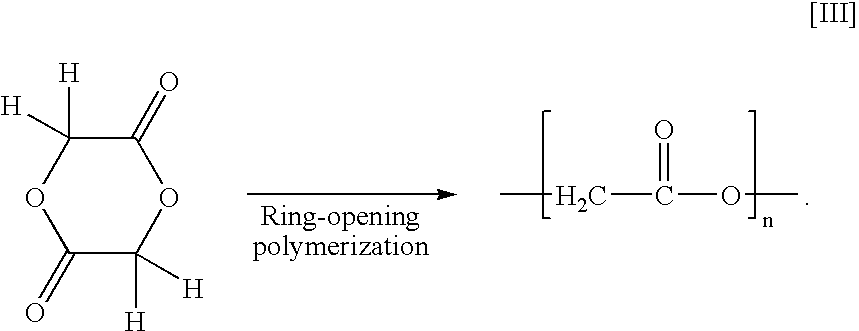Polyester production process and reactor apparatus
a technology of polyester production process and reactor apparatus, which is applied in the direction of chemical apparatus and processes, chemical/physical/physical-chemical stationary reactors, chemical/physical/physical-chemical processes, etc., can solve the problems of difficult to take and recover polyester products from reactor apparatus, low volume of production, and unsuitable cases, etc., and achieve the effect of easy recovery
- Summary
- Abstract
- Description
- Claims
- Application Information
AI Technical Summary
Benefits of technology
Problems solved by technology
Method used
Image
Examples
example 1
One hundred (100) grams of glycolide and 0.01 gram of tin dichloride.2H2O were charged into a stainless steel (SUS304) metal circular tube (reactor) of 24 mm in inner diameter and 350 mm in length, which tube was closed up at one opening with a silicone rubber stopper. Then, the other opening was closed up with a silicone rubber stopper. The said tube was immersed in an oil bath of 220° C. for ring-opening polymerization by heating.
Three hours later, the said tube was taken out of the oil bath, and left standing for cooling over 2 hours. Two hours later, the silicone rubber stoppers were put off and the said tube was placed in a vertical state where it was lightly shaken so that a bulky mass of polyglycolic acid of 100 grams was discharged (with the recovery yield=about 100%).
example 2
One hundred (100) grams of glycolic acid were charged into a stainless steel (SUS304) metal circular tube (reactor) of 24 mm in inner diameter and 350 mm in length, which tube was closed up at one opening with a silicone rubber stopper. Then, the said tube was immersed in an oil bath of 220° C. with the stopper down. Dehydration under a reduced pressure of 20 to 50 mmHg was carried our through the other opening in the said tube. Two hours after the dehydration polycondensation was performed in this way, the distillation of condensed water was not found. Then, the application of the reduced pressure and the heating of the oil bath were stopped, followed by spontaneous cooling.
Two hours later, the said tube was taken out of the oil bath the temperature of which dropped to 100° C., and the silicone rubber stopper was put off. Then, the said tube was lightly shaken in a vertical state, so that a bulky mass of polyglycolic acid of 76 grams was discharged (with the recovery yield=about 10...
example 3
One hundred (100) grams of glycolide and 0.01 gram of tin dichloride.2H2O were charged into a stainless steel (SUS304), bottomed metal circular tube (reactor) of 24 mm in inner diameter and 300 mm in length, which tube had a taper gradient of 10%. Then, the said tube was closed up at an opening with a silicone rubber stopper. The said tube was immersed in an oil bath of 220° C. for ring-opening polymerization by heating.
Three hours later, the said tube was taken out of the oil bath and left standing for cooling over 2 hours. Two hours later, the silicone rubber stopper was put off, and the said tube was turned upside down, instantaneously whereupon a bulky mass of polyglycolic acid of 100 grams was discharged due to its own weight (with the recovery yield about 100%).
PUM
| Property | Measurement | Unit |
|---|---|---|
| Fraction | aaaaa | aaaaa |
| Temperature | aaaaa | aaaaa |
| Structure | aaaaa | aaaaa |
Abstract
Description
Claims
Application Information
 Login to View More
Login to View More - R&D
- Intellectual Property
- Life Sciences
- Materials
- Tech Scout
- Unparalleled Data Quality
- Higher Quality Content
- 60% Fewer Hallucinations
Browse by: Latest US Patents, China's latest patents, Technical Efficacy Thesaurus, Application Domain, Technology Topic, Popular Technical Reports.
© 2025 PatSnap. All rights reserved.Legal|Privacy policy|Modern Slavery Act Transparency Statement|Sitemap|About US| Contact US: help@patsnap.com



